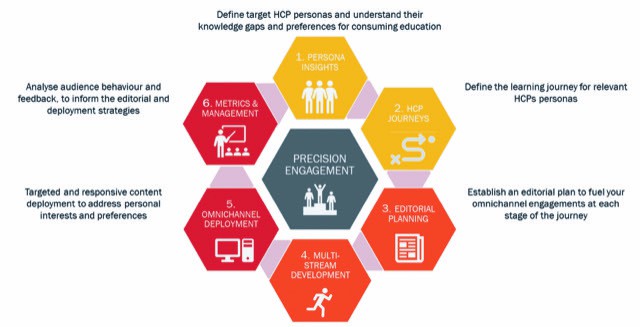

Effective omnichannel medical communication requires the rapid delivery of high-quality content. As well as adapting and personalising the content already in the medical communication plan, we need to consider our presence and share of voice in the many channels with which healthcare professionals (HCPs) connect.
This requires thinking about new types of medical content curated from various credible sources, as well as new approaches to the rapid approval and deployment of content to meet HCPs’ evolving needs.
Right content, right time, right place
Omnichannel communication strategies produce an improved, personalised experience for HCPs by delivering the right medical content, at the right time and in the right place to meet their needs.
This enhances audience engagement and improves the impact of medical education through accessibility, convenience and relevance. This is becoming the standard for medical communication programmes, creating new expectations on what needs to be achieved.
Keeping up with the rapid pace of change
While omnichannel strategies are increasingly being adopted by Medical Affairs teams, content development strategies often fail to keep up with the need to fuel omnichannel delivery.
To fully deliver on the promise of omnichannel, we need to ensure all engagements and content are:
- Aligned with audience interests, needs and preferences
- Accessible, in the right format and channel
- Of consistent quality and tone to build trust
- Delivered quickly, so they are timely and relevant
- Of sufficient frequency to maintain place of mind and ongoing learning. Achieving this requires a robust approach to plan, create and deliver medical content efficiently and with impact. This can be divided into six phases (see image).

Gaining audience insightsThis is best achieved by gathering data from internal sources (eg previously commissioned market research) and augmenting it with primary research to fill insight gaps to allow the development of robust personas.
This ultimately ensures that the content plan will meet well defined audience needs. By building systems for agile collection and application of real-time audience feedback, we can also ensure that we refine our audience understanding as the content is deployed.
Planning the delivery of high-quality content
Far more active and modular content planning is required to ensure we develop relevant, engaging and motivating medical content that addresses identified HCP needs and preferences.
Editorial plans define the content strategy for each audience segment, based on the insight-led personas developed. Alongside the medical content topics, this also covers format and channel preferences, to align with the persona preferences and learning styles.
Medical Affairs teams have historically delivered high-quality medical communication materials; however, internal resource constraints, limited experience with data-driven methods and time-consuming review processes restrict the output of medical materials and limit the potential implementation of an effective omnichannel strategy.
Implementing this new approach
Producing medical content to address the needs and preferences of different audience segments, and the scale and frequency needed for ongoing, personalised engagement, requires a dramatically new approach.
This can be achieved using multi-stream content development, with streams of curated and independently developed content supplementing the editorial plan.
By implementing alternative governance models, content streams can achieve fast- track approval, delivering immediate value to HCP audiences and starting them on their educational journey.
Effective delivery of omnichannel content
Omnichannel communication is often driven at a local level, based on the unique audience insights, regulatory environment and channel mix of that market. As well as planning for global audience journeys, it is important to prepare dynamic content that can easily be transcreated and adapted to the omnichannel frameworks of local markets.
Targeted content deployment also enables every piece of medical content to act as a source of data, based on how the HCP audience interacts with it.
Collation and analysis of audience behaviour means we can continuously inform the editorial and deployment plan, both to refine our personas and to support a personalised experience at the HCP level.
Precision engagement in content delivery
Every piece of content represents an opportunity to start conversations with HCPs and move them forward on their educational journey, from awareness, to trust, to advocacy.
To deliver medical communications that reaches, engages and impacts HCPs, you must re-evaluate your audience understanding and reassess your medical content development process to ensure you provide value and relevance in an omnichannel world.
Dominic Sloane is Director at Ology Medical Education, Richard Marshall is Director, Business Development at Adelphi in Healthcare Communications.





